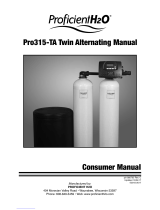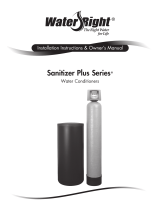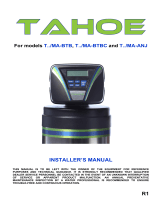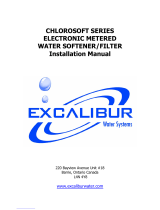
17
1.
Salt Usage: See your water conditioning professional for a rec-
ommendation on the best type of salt for your application.
2. Brine Tank Cleaning:
a. Remove brine tank cover.
b. Scoop out as much old salt as possible.
c. Disconnect brine tubing from safety brine valve at brine well.
d. Remove safety brine valve from brine well.
e. Place one hand in brine well to hold overow nut and
remove 2 piece overow.
f. Remove optional brine well and grid plate, if used,
from brine tank.
g.
Remove any remaining salt and/or impurities from brine
tank.
h.
Using clean water and a brush or rag, wipe and rinse
inside
of brine tank. Also wipe and rinse the grid plate and
brine well.
i. Reassemble brine tank reversing steps c - f. Note: If grid
plate is used and it is damaged or cracked, replace
with new one.
j. Put brine tank in place making sure there is no debris or
foreign material beneath it.
k. Reconnect brine tubing to safety brine valve.
l. Manually add 6 inches of water to the brine tank (or to
approximately 1” above the grid plate, if used).
m. Add new salt. Important: Do not add the old salt which
was removed earlier unless it is clean and not mushy.
We recommend using new salt.
n. Follow the disinfection instructions found on page 5.
o. Put on brine tank cover.
MISCELLANEOUS
In cold weather climates it is common for plumbing systems that
are not in use to be “winterized“ or drained of all water to prevent
any damage that may be caused by the excessive expansion of
water when it freezes. To prevent damage to a water softener it
must be properly drained also. A simple way to properly drain
or winterize a water softener is to use compressed air to force
all of the water out of the softener mineral tank. The following
procedure will explain the process:
1) Initiate the softener into a manual regeneration cycle. Advance
control to backwash and allow it to complete the backwash
cycle (this will clean the media) and start into the brine-draw
cycle. Note: Be sure there is salt in the brine tank and water
has been in contact with salt at least 20 minutes. Allow the
regeneration to continue in the brine draw cycle until the
brine is drawn out of the salt keeper and the air check at
the bottom of the brine pick-up tube shuts off. At this time
no more brine is introduced into the softener and the slow
rinse process begins.
2) Turn the water supply inlet and outlet valves off to the water
softener as soon as the air check shuts off and no more brine
is being drawn into the softener (at the beginning of the slow
rinse process).
3) Unplug the electric power leaving the softener control valve
in the brine draw cycle.
4) Remove the brine rell elbow assembly from the control
valve. Remove the rell ow control retainer assembly from
the elbow. Reinstall the elbow assembly and secure with the
locking clip. Disconnect the brine tube at the top of the salt
keeper and force air into the brine tube toward the softener
mineral tank and control valve. The air will force the brine/
water solution that was drawn into the mineral tank out to
drain through the control valve drain line. (An air compressor
blow gun attachment with a portable air compressor works
well.) Reinstall the brine line ow control retainer in side
of the rell elbow assembly. Reinstall the brine rell elbow
assembly and secure with locking clip.
CAUTION: You do not want to apply any more pressure than
necessary to force the brine/water out of the mineral tank.
The small amount of brine/water that may be left in the
mineral tank will not expand enough to cause any damage
to the softener when it freezes.
If your softener is equipped with an optional bottom drain
on the mineral tank, you will have to follow all of the same
procedures with the exception of the need for compressed
air. With the brine tube disconnected from the salt keeper,
raise it to a level above the softener control valve and tem-
porarily secure it in this position. Now open the drain valve
at the bottom of the mineral tank and allow all brine/water
to drain from the mineral tank.
CAUTION: If a hose is connected to the drain valve to direct
the brine/water to a oor drain be sure it runs downward
and is unobstructed. When brine/water quits running at the
drain, be sure to leave the drain valve open until you start
the system up again.
5) At this time the salt keeper has very little water left in it. What
liquid is left in the salt keeper is saturated brine, provided
that there is still salt left in the tank. Saturated brine will not
freeze solid and cause any damage and does not have to
be drained any further from the brine tank.
If there is no salt left in the salt keeper when the system is
drained we recommend dumping all of the water out of the
brine tank at this time. See brine tank cleaning instructions.
(#2 in miscellaneous section, below)
6) CAUTION: It is important at this time to be assured that the
inlet/outlet water supply piping is properly drained. Depend-
ing on how the water supply piping was routed to the water
softener control valve, a water loop or trap may have been
created.
Sometimes drain valve(s) are installed at the bottom of the
loop to assure all water can be drained out. If not it may be
necessary to disconnect the control valve from the piping
system and open the inlet/outlet valve(s) to allow all the water
to drain from the piping. This should be done when the rest
of the plumbing system is drained.
7) Draining or winterizing of your softener is complete. Refer
to the start-up procedures on page 7 when you are ready to
start your softener.
WATER SOFTENER DRAINING PROCEDURE


























